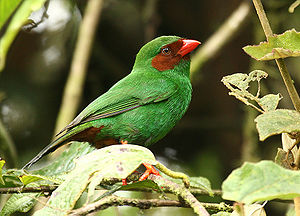Parrot tangars
| Parrot tangars | ||||||||||||
|---|---|---|---|---|---|---|---|---|---|---|---|---|

Parrot tangars |
||||||||||||
| Systematics | ||||||||||||
|
||||||||||||
| Scientific name of the genus | ||||||||||||
| Chlorornis | ||||||||||||
| Reichenbach , 1850 | ||||||||||||
| Scientific name of the species | ||||||||||||
| Chlorornis riefferii | ||||||||||||
| ( Boissonneau , 1840) |
The parrot tangar ( Chlorornis riefferii ) is a species of bird belonging to the tangar family (Thraupidae). The species has a large range that includes the South American countries Bolivia , Peru , Ecuador and Colombia . The IUCN assesses the population as Least Concern .
features
The parrot tanga reaches a body length of about 20.5 centimeters. The beak and legs are salmon red. Most of the bird is deep green with a few chestnut highlights. The face mask, throat, abdomen and under tail coverts are chestnut red. The iris is red-brown. The species has no significant sexual dimorphism .
behavior
The parrot tangars are usually seen in groups of six to eight birds. It happens that it also accompanies other species of tangerine. It feeds on fruits and insects in all stratification layers .
distribution and habitat
The parrot angars are usually found in the humid mountain forests of the eastern slopes of the Andes at altitudes between 2000 and 3500 meters. Here it moves mainly in semi-open vegetation and on the edges of forests. They are very rarely found in the forest.
Subspecies
So far, five subspecies are known, which differ mainly in their color.
- C. r. riefferii (Boissonneau, 1840) nominate form
- C. r. dilutus ( Zimmer, JT , 1947) Occurrence is the province of Chachapoyas . Resembles bruises on the forehead C. r. elegans, but the face mask, back abdomen and under tail coverts are significantly lighter.
- C. r. elegans ( Tschudi , 1844). Tschudi described this subspecies under the name Saltador elegans. It occurs in the Junín region (Pumamarca, Sillapata, Gloriapata, Auquimarca, Hauacapistana). C. r. elegans has a distinct bruise on its forehead. The chestnut-colored throat is somewhat wider than in the nominate form.
- C. r. celatus (Zimmer, JT, 1947) Occurs near Limbani in southeastern Peru. Similar to bolivianus darker green. Has a diagonal line behind the maroon area of the head that is close to the elegans bruise but is not clearly blue. It is more of a dull green to gray-blue.
- C. r. bolivianus ( Berlepsch , 1912) Occurs at Cillutincara in Bolivia. Much darker green than nominate form and no bruise on the forehead.
Naming
In the 1830s and 1840s, the Dutchman Riéffer traveled through Colombia. Presumably in 1838 or 1839 he sent bird hides to Europe. The delivery was known to Auguste Boissonneau, Frédéric de Lafresnaye , Marc Athanase Parfait Œillet Des Murs and Jules Bourcier . You described many of the bellows in the magazines 'Revue Zoologique' and 'Revue et Magazin'. More of Riéffer's bellows went to Coenraad Jacob Temminck . It was precisely this Temminck who advised Boissonneau to name the parrot tangare ( Chlorornis riefferii ), which he identified as a new species, after Riéffer. The parrot tangare was first described under the scientific taxon Tanagra (gros-bec?) Riefferii . Later one finds u. a. in Berlepsch's contribution to the negotiations of the 5th International Ornithological Congress, Psittospiza riefferi bolivianus . Boissonneau followed Temminck's advice and also named the Goldbandkotinga with the name Pipreola riefferii (original: Ampelis riefferii ).
literature
- Thomas Schulenberg , Douglas F. Stotz , Daniel F. Lane: Birds of Peru. Princeton University Press, 2007, ISBN 978-0-691-04915-1 , p. 558.
- Robert S. Ridgely , Paul J. Greenfield: Birds of Ecuador Field Guide. Volume 1, Cornell University Press, 2001, ISBN 978-0-8014-8720-0 , p. 740.
- Robert S. Ridgely, Paul J. Greenfield: Birds of Ecuador Field Guide , Vol. 2, Cornell University Press, 2001, p. 648, ISBN 978-0-8014-8721-7
- Steven L. Hilty , William L. Brown: A Guide to the Birds of Colombia. Princeton University Press, 1986, ISBN 978-0-691-08372-8 , p. 640.
- Edward S. Gruson: Words For Birds: A Lexicon Of North American Birds with Biographical Notes , Quadrangle Books, 1972, p. 161
- Robert S. Ridgely, Guy Tudor , William Liddle Brown: The Birds of South America. Volume I: The Oscine Passerines. Jays and Swallows, Wrens, Thrushes, and Allies, Vireos and Wood-Warblers, Tanagers, Icterids, and Finches. University of Texas Press, 1989, ISBN 978-0-292-70756-6 , p. 299.
- John Todd Zimmer : The genera Sericossypha, Cholorospingus, Cnemoscopus, Hemispingus, Conothra Upis, Chlorornis, Lamprospiza. American Museum Novitates, No.1367, 1947, pp. 20f.
Individual evidence
- ↑ Chlorornis riefferii in the endangered Red List species the IUCN 2011. Posted by: BirdLife International, 2009. Accessed November 17, 2011th
- ↑ Zoological-Botanical Society Austria Psittospiza Riefferi (old name) (PDF; 517 kB)
- ↑ American Museum Novitates No 1367 Chlorornis riefferii dituta (English; PDF; 3.7 MB)
- ↑ Archive for Natural History 1844 150. 4. S. elegans Tschudi page 288 (Latin.)
- ^ Cornell University Library The distribution of bird-life in Colombia; a contribution to a biological survey of South America (Engl.)
- ↑ Muséum national d'histoire naturelle List of types d'oiseaux des collections du Muséum national d'Histoire naturelle ( Memento of the original dated June 12, 2011 in the Internet Archive ) Info: The archive link was inserted automatically and has not yet been checked. Please check the original and archive link according to the instructions and then remove this notice. (French; PDF; 672 kB)
- ^ Oiseaux nouveaux ou peu connus de Santa-Fé de Bogota Original article in Revue zoologique par la Société cuviérienne (French)